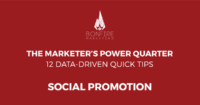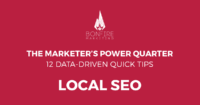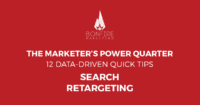Every day at MozCon packs enough information to fill the back of a 1996 Chevy Astro van. Lucky for you, we’ve pared down the first day into five key SEO takeaways from five of the day’s presenters.
1. Identify conversion optimization with 5 Google Analytics Reports.
Cara Harshman began the day discussing conversion optimization. According to her presentation, 70 percent of marketers said conversion optimization is a higher priority in 2016. Fifty percent of teams will allocate more budget to conversion optimization. But where do we begin to identify opportunities for improved conversion rates?
Use these five Google Analytics Reports to reveal bottlenecks in your conversion paths:
- Funnel report (GA): Are there any pages or steps where users routinely drop out?
- Heat map on home and high intent pages: What pages are getting the most clicks from your homepage? Are they pages you need for users to convert?
- Form error submission reports: Are your conversion forms too long or complex?
- Exit/bounce rate report: Which pages are preventing users from exploring/staying on your site?
- High-traffic/low-conversion landing pages: Traffic doesn’t always mean value. If you have pages that get a lot of eyes, update the content so traffic turns into conversions.
2. Know why you’re relaunching your website and take care of the backend first.
Laurel Vaccarello discussed one of the most arduous endeavors any digital marketer will go through: the site redesign. The first step to relaunching your site is to know why you’re relaunching your site. Is it purely vanity? Is it to simplify CMS or restructure navigation to improve conversion paths? Start with a clear goal, then identify the metrics you will use to measure the goal. Finally, establish a timeline. (Hint: The redesign will take longer than you think, so plan accordingly.)
In addition to setting goals, timelines, and metrics, Vaccarello recommends starting the redesign with the backend updates. Even if you know you’re not going to keep copy or design, it’s easier to make backend adjustments with the same design. Clean up backend — hosting, CMS, etc. — then build out your frontend.
3. Information architecture of SEO: Establishing local topic authority.
Joe Hall discussed how successful information architecture for SEO should focus more on where you’re going rather than what you’re doing. Where you’re going is marketing, he says, and what you’re doing is web development.
Joe made a point that is a bit shocking but highly insightful: Your blog should not be separate from the rest of your site on its own subdirectory. Why? If you have a blog subdirectory on a WordPress site, WordPress has its own taxonomy structure that keeps this content in a silo. After you gain traffic and links, it all stays on the blog and does not transfer over to the main site.
Internal linking and moving pages is just a Band-Aid; SEOs need to start growing sites where content is put right alongside product pages and lead forms. Doing so creates local topic authority.
What is local topic authority? Having everything that’s topical for which you want to rank in the same section. If you want to rank for tennis shoes, but your content and authority for tennis shoes is spread out across the site, it will be much more difficult to rank than if everything tennis shoes is in one place. Integrate your content in a way that’s segmented to help Google understand what you’re trying to achieve.
4. Mobile traffic is growing, and it doesn’t behave like desktop traffic.
Talia Wolf noted Mobilegeddon wasn’t the end but merely the beginning. The average website has over 65 percent mobile traffic, but marketers still treat these visitors as desktop traffic. When we’re on mobile phones, we’re different people in a different state of mind. We’re on the go, in a meeting, watching television, or shopping and comparing prices. The mobile experience should reflect that.
Over 60 percent of mobile web visitors expect sites to load in less than three seconds. One additional second of load time causes 11 percent fewer page views, a 16 percent decrease in customer satisfaction, and a 7 percent loss in conversions. This helps create a 270 percent gap between mobile and desktop conversions.
Moral of the story: Make your mobile experience as fast and efficient as possible.
5. Google Featured Snippets: There’s low-hanging fruit to be plucked.
Rob Bucci spoke on one of my favorite topics: Google Featured Snippets. These snippets put a gigantic box around your content to say “This is the best answer for the topic you’re seeking.” They help level the playing field because you don’t have to rank number one to be prominently featured in search — as long as you provide the best answer to a query.
The three snippet types are:
- Paragraph snippet.
- Table snippet.
- List snippet.
Approximately 29 percent of snippets use tables, which provide the best UX for certain queries, like “best schools” or “home run leaders” where there are several columns of data. Right now, there are plenty of weak Featured Snippets you can displace by improving your information and using the format Google really wants to see for a query. If you come across a query that returns a list snippet that would be better served with a table, create a table on your site, mark it up with schema, and watch your content swipe that Featured Snippet.
Stay tuned for more fun facts and interesting insights from Bonfire’s adventures as MozCon 2016.
More Content
The Marketer’s Power Quarter: Boost Social Promotion
This is the ninth in a 12-part series of quick-fix tips to improve your digital marketing results. Catch up on our last tip, and subscribe to our newsletter to get
The Marketer’s Power Quarter: A Local SEO Strategy
This is the sixth in a 12-part series of quick-fix tips to improve your digital marketing results. Catch up on our last tip, and subscribe to our newsletter to get
The Marketer’s Power Quarter: Better Ad Retargeting
This is the fifth in a 12-part series of quick-fix tips to improve your digital marketing results. Catch up on our last tip, and subscribe to our newsletter to get the




Leave A Comment